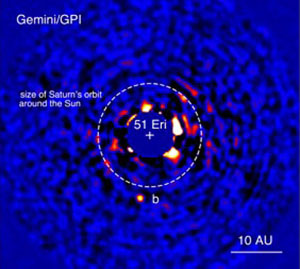main content begins
In late 2013, an innovative instrument called the Gemini Planet Imager (GPI) was installed on the 8.1-meter telescope at the Gemini South Observatory, Cerro Pachon, Chile. In November 2013, it achieved first light, marking the beginning of a new era of exoplanet discovery.
GPI lets astronomers observe these objects directly and analyze the light coming from them. It is an extreme adaptive-optics, imaging polarimeter/integral-field spectrograph, which provides diffraction-limited data between 0.9 and 2.4 microns.
The instrument was developed by an international team led by Stanford University’s Prof. Bruce Macintosh and the University of California Berkeley’s Prof. James Graham; Graham worked on GPI while director of the Dunlap Institute. At the Dunlap, the team working on the instrument’s development also included Dr. Jeffrey Chilcote, Prof. Quinn Konopacky, Dr. Jérome Maire, and PhD-candidate Max Millar-Blanchaer.
GPI’s adaptive optics technology greatly reduces the blurring effect of the Earth’s atmosphere, resulting in higher-resolution images. A coronograph blocks the light of the star which would normally hide the much dimmer exoplanet. And a spectrograph separates the light of the exoplanet according to wavelength, allowing astronomers to study the distant world’s composition, temperature, age and other characteristics, and better understand how planetary systems form and evolve.
In early 2015, the GPI Exoplanet Survey or GPIES, began. The core science program of the GPI instrument, GPIES will run through 2017, targeting some 600 nearby stars in search of young, Jupiter-like exoplanets. Chilcote, Maire and Millar-Blanchaer are part of the international team conducting the survey and analyzing new data.
In August 2015, the team announced GPI’s first discovery: a first-of-its-kind “young Jupiter” called 51 Eri b. In September 2015, the team released an animation of exoplanet β Pic b in orbit around its parent star, β Pictoris.

Discovery image of the planet 51 Eridani b with the Gemini Planet Imager taken in the near-infrared light on December 18 2014. The bright central star has been mostly removed to enable the detection of the exoplanet one million times fainter. Image: J. Rameau (UdeM) and C. Marois (NRC Herzberg)
A series of images taken between November 2013 to April 2015 with the Gemini Planet Imager (GPI) on the Gemini South telescope in Chile shows the exoplanet β Pic b orbiting the star β Pictoris, which lies over 60 light-years from Earth. Image credit: M. Millar-Blanchaer, University of Toronto; F. Marchis, SETI Institute